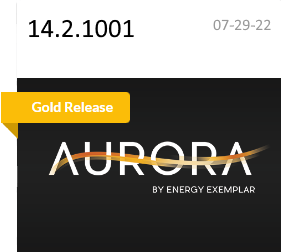Version 15.0 is now available as a General Availability Release!
 Aurora on PLEXOS Cloud - Aurora places powerful, accurate analysis capabilities in your hands with the high-performance, cloud-enabled features to scale with your needs. Taking a cloud-enabled approach to your studies enables you to facilitate improved collaboration and access high-performance computing power integrating PLEXOS Cloud, the next generation SaaS delivery of PLEXOS, which brings you deeper contextual insights into energy market modeling. Using Aurora Cloud, you can now upload your projects to the Cloud, sync them, run the simulation in the Cloud, and then download your project results from the Cloud to your local machine. You can view your simulations on the Web and view the status of all your projects in one place.
Aurora on PLEXOS Cloud - Aurora places powerful, accurate analysis capabilities in your hands with the high-performance, cloud-enabled features to scale with your needs. Taking a cloud-enabled approach to your studies enables you to facilitate improved collaboration and access high-performance computing power integrating PLEXOS Cloud, the next generation SaaS delivery of PLEXOS, which brings you deeper contextual insights into energy market modeling. Using Aurora Cloud, you can now upload your projects to the Cloud, sync them, run the simulation in the Cloud, and then download your project results from the Cloud to your local machine. You can view your simulations on the Web and view the status of all your projects in one place.
Energy Converter - The energy conversion logic has several notable enhancements to make hydrogen modeling easier and fit your specific use case. In the Energy Conversion input table, we have added a new Contributing Resources column which can be used with the Zone input type. The input for this column is a list of resources or resource group. When specified, the input amount will be limited so that it does not exceed the total output of the resources. Additionally, there is a new Fuel output type which utilizes the all-new fuel inventory logic to inject the conversion output into the fuel’s inventory. We have included two new Fuel table columns, Initial Inventory and Injection that can be used with or without the new energy conversion fuel output type. The Initial Inventory column is used to specify the mmBtu available in the fuel at the start of the study. The Injection input is time series enabled and can be used to inject fuel into the inventory each hour. The usage of the fuel will be limited by the total inventory each hour. We have included Working_Inventory and Total_Injection in the Fuel output tables to make tracking a given fuel’s inventory and injection as clear as possible.
Storage Enhancements - For Aurora 15.0, we have rounded out the generation limit offerings with the new Daily Generation Limit column in the Storage table. This column is time series enabled and accepts a factor which is multiplied by the resource capacity and will limit the storage generation by that amount each day.
Long-Term - There is a new supplemental parameter Write RMT To Output which will include the Resource Modifier and Capacity Price tables in the output database. If using the option to Keep All Iterative RMT, all iterations will be written to the output database. This switch is enabled automatically when running long term studies in Cloud.
Portfolio Optimization - There is a new option to use monthly reserve margin targets with Portfolio Optimization studies. This option is called Port Op Use Monthly Reserve Margin Targets and can be found in the Supplemental Parameter table. Specifying True for this parameter will enable the logic for monthly reserve margins. In addition to this enhancement, there is a new output table, PortOp_MonthReport which contains portfolio performance information at the monthly level. To enable reporting, the portfolio optimization Output Report Level must be 2 or greater and the Time Period must be less than Year.
Inertia - The Operating Pools table has a new column Inertia Requirement to enter a pool-wide inertia target for the system. Each commitment resource in the pool can contribute to the inertia requirement as specified in the Inertia Constant column. The total inertia provided by each online resource is equal to [Inertia Constant]*[Capacity]. When these inputs are populated, a constraint will be added to the optimization problem for each period to ensure that the online capacity provides enough inertia to meet the pool requirement. If it cannot be met, the requirement can be relaxed based on the Inertia Relaxation Cost. In the output, the Inertia column in the Pool and Resource tables report the total inertia provided.
Custom Constraint - The Operating Pools table has a new column Inertia Requirement to enter a pool-wide inertia target for the system. Each commitment resource in the pool can contribute to the inertia requirement as specified in the Inertia Constant column. The total inertia provided by each online resource is equal to [Inertia Constant]*[Capacity]. When these inputs are populated, a constraint will be added to the optimization problem for each period to ensure that the online capacity provides enough inertia to meet the pool requirement. If it cannot be met, the requirement can be relaxed based on the Inertia Relaxation Cost. In the output, the Inertia column in the Pool and Resource tables report the total inertia provided.
Emission - This release includes enhancements to the emissions logic with the ability to model emissions curves. This logic was implemented for the NOx emissions type to specify a different emission rate for different segment levels. However, the logic is generic and can be used with any type. There is a new column in the Heat Rate Definition table called Emission Rate Factor 1 ( 2,3, ...). It is used to specify a factor to be applied to the base emission rate and can be changed for each segment. In the Emission Rate table, we have added the Emission Rate Factor Reference column. This column is used to link the emission type with the factor from the heat rate definition table. The input for the Emission Rate Factor Reference column is the number from the Emission Rate Factor column. With these two new inputs, emission curve modeling is as flexible as you need it to be. Furthermore, to address chronological Emission constraint relaxations, we have added a new Relaxation Cost column to the Constraint table. An input of -1 into this column will ensure that your emission (or other) constraint is prevented from relaxing for the chronological portion of the constrained dispatch solve.
CSV Output Format - Clients can now directly output simulation results as comma separated values or CSV files. Previously, this format was only available through an output plugin, but it’s now natively supported right alongside XMP SQL, XML, SQL Server and others. And with the extensibility of our new output code, we’ve asked Aurora users to tell us about other output formats they’d like us to support. In the future we may ship support for Oracle, Parquet or something completely new.
Gurobi - We improved the Gurobi optimization engine with the recent release of Gurobi 10.0.1.
Mosek - This release includes an update of the Mosek solver to version 10.1.9.
Check Out The Release Notes! - Click Release Notes for full details on all the enhancements that have been added in the Aurora v15.0 release. For all installation details, review the Install Guide included with this release.

Want to deliver energy modeling insights with more impact?
Learn More About PLEXOS Cloud Analytics QuickStart Program and Sign Up: https://www.energyexemplar.com/plexos-cloud-analytics-quickstart-program

Xpert Learning in 2023
You can obtain Aurora Core Certification or freshen up on your Aurora knowledge by taking any of our eleven (11) core training sessions.

To access Xpert Learning, enter the URL in your browser: https://xpert.energyexemplar.com/page/aurora-training-path, and then sign in and register for all the courses that are free to our Aurora customers.
So far, in 2022, we have grown to 34 certified clients and an all-time total of 77 clients certified!
Support Community Client Portal
We invite you to visit the Energy Exemplar Client Portal to download the latest install from the Software link. The URL is: https://energyexemplar.com/client-login/
Energy Exemplar's Client Portal gives you easy access to everything in the support community. Be sure to sign up so you can access our newest content, datasets, documentation, support and software.
- Submit and review support cases.
- Download licensed software and the latest datasets.
- Learn from monthly webinars and the new xPert online courses.
- Explore the ever-growing Knowledge Base articles.
- Access recordings, slides from past training's, and UGMs.
Join our Support Community to create and manage support cases. If you are not already a member, email Support at support@energyexemplar.com to sign up! The energy industry is changing fast, and we're here 24/7 to make sure you're staying ahead of the game.
